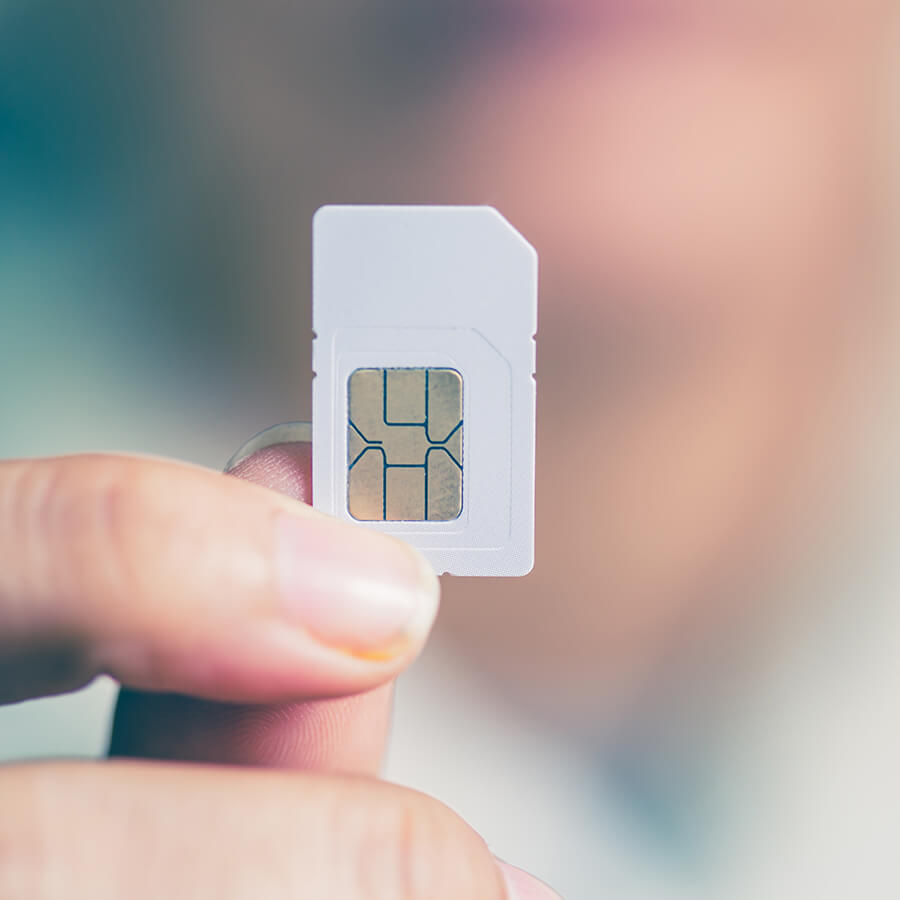Jitna Baghani | May 20th, 2022
Complete guide to SIM cards
Mobile phones are part of our everyday lives; we use them for everything from our weekly shops, communicating with friends and family around the world, and even running entire businesses on the go.

Despite how dependent we’ve become on our phones, we might not know the details of how they work, or what their individual parts can do. Understanding the ins and outs of SIM cards can help optimise your current mobile usage, or even help you choose your next handset, and this guide aims to give you all the information you need.
What is a SIM card?
Every mobile phone user has probably heard of SIM cards, but you might not know just how powerful these tiny pieces of plastic are. SIMs are small but mighty, with much more capability than you might expect.

The acronym ‘SIM’ stands for Subscriber Identity Module, which doesn’t reveal much, but a SIM card is essentially a small piece of plastic with an integrated circuit (computer chip) that you plug into a device.
SIMs might be small, but they can hold a lot of information, including a unique serial number, an international mobile identifier, security information, current services linked to the SIM card (if any), and often network-specific details linked to the mobile service provider that issued the card. SIMs have two passwords linked to each card: a PIN (personal identification number) which is used to access the contents of the SIM, and a PUK (personal unblocking key) for unlocking or resetting your PIN.
Essentially, if you have a network-connected or capable device, you’ll need a SIM card to connect to that network. Devices that require SIMs include mobile and satellite phones, mobile Wi-Fi devices (MiFis), smart watches, and select computers, tablets, cameras and e-readers.
What are the different types of SIM cards?
When SIM cards were first introduced, they were roughly the size of credit cards, though thankfully bulky SIMs are a thing of the past. These days, you’ll find relatively smaller SIMs, and there are a few sizes available. There are use cases for different SIMs, and we’ll look at common SIM sizes and usage next.
SIM card types by size
SIM cards are currently available in three different sizes: standard, micro or nano. The SIM your device needs will depend on the age, shape and functionality of your device.
- Standard SIM cards – Standard SIMs are the biggest size currently available, but since their debut in the mid-90s, they’re anything but standard these days. Unless you’re still playing Snake on your old Nokia 5110, you probably won’t need a standard SIM
- Micro SIM cards – Micro SIMs are mid-size SIM cards, smaller than standard, and use less plastic than standard SIMs. Micro SIM cards debuted in the early 2000s, so they’re increasingly becoming outdated
- Nano SIM cards – Nano SIM cards are the smallest of the bunch, and they debuted in 2012. Nano SIM cards are essentially just a chip with a slim layer of plastic surrounding the circuit. The vast majority of modern devices use Nano SIMs
- Combi SIMs – A combi SIM cleverly combines all three sizes of SIM cards into one handy unit. The individual SIM cards within the combi SIM have perforated edges, so you can easily pop out the one your device needs. Mobile network providers often provide these because they sell a variety of devices with different SIM size requirements
- e-SIM cards – A recent development is the e-SIM, which is an integrated SIM card you can’t remove from the device. E-SIMs are set to replace removable SIM cards. Newer devices like the iPhone XS include slots for both a physical SIM and an e-SIM, so you can actually use multiple mobile networks on the same phone, if that’s your thing
Different SIMs have different uses
The device or type of service you want to use might dictate which SIM card you need.
Mobile phone SIMs
The most common use cases for SIM cards are mobile phones. A SIM card is basically what links your device with your chosen network. Your device’s SIM card makes it possible to make phone and video calls, send texts or surf using 3G, 4G, or 5G when you’re not connected to Wi-Fi. SIMs are transferable, so if your device gets ruined, you can just use your SIM in another device, as long as the SIM card isn’t ruined too. Mobile phone SIM cards offer storage space, which is usually the default location to save your SMS messages, your contacts, and other data. You also have the option to use cloud services to save that information elsewhere if you prefer.
Data-only/tablet SIMs
Data-only SIMs are used to connect devices like tablets, which don't make or receive calls, to the internet. A data-only SiM is essentially the same as a mobile SIM, but without the calling or texting capability. Data-only SIMs are available from all major mobile service providers, and you can usually find unlimited or bundle offers available. They’re brilliant for keeping connected on secondary devices, especially when you don’t have access to Wi-Fi.
MiFi SIMs
Mi-Fi, or Mobile Wi-Fi offers a broadband connection when you’re out and about and don’t have access to or don’t want to use a mobile phone signal to connect. Mi-Fi is an excellent alternative for connectivity in remote areas where strong Wi-Fi or mobile signals aren’t available. Mi-Fi devices are pocket-sized and portable, so you can stay connected pretty much anywhere. Your Mi-Fi device and a data-only SIM card are all you need to get your connection up and running when you’re on the go, and then you can connect to the service as you would connect to Wi-Fi.
Car SIMs
Newer models of cars now come with integrated SIM card slots, so you can have an internet connection in your car. It might sound over-the-top, but when paired with a built-in sat-nav or GPS system, you can get real-time traffic updates or check opening hours of wherever you’re headed safely while you're in the car. Some cars offer mobile apps to keep you connected to your car, which is handy if you’ve forgotten where you’ve parked or want to double-check you’ve locked your doors and windows.
How to insert your SIM card
So, you’ve just purchased a shiny new device and want to know how to get the SIM installed. We've got you covered.
Mobile phones
SIM card installation in mobile phones is easy, and you just need to follow a few simple steps to install or switch out a new SIM card. Before you do anything, turn your device off. Next, be sure to remove your phone’s cover, if you have one.
Now we’ll look for your SIM card tray, where SIM cards are held in most handsets. Look closely at the outer edges of your phone and look for a thin rectangular panel with a small hollow dot on either end of it. Your new phone might have come with a SIM card removal tool, but otherwise any thin sharp object like a paperclip or needle will do. Take your SIM card removal tool and push gently into the small hollow hole on the tray panel until the tray pops out. If your phone doesn’t have the panel, you can remove the battery cover and your SIM card will go into a slot instead of a tray. Remove the battery cover and locate the SIM slot.
Next, you’ll insert your SIM card either in the tray or the slot, depending on your phone. Your SIM has a tiny notch on one corner to guide you, so you know which way to insert it. Slide the tray back in or replace the battery and cover when finished.
When removing an old SIM card (if any), eject the tray and pick up the card at the edges or turn the tray over so it falls out, taking care to avoid the gold connectors on the SIM card to avoid damaging it. If your SIM is under the battery cover, you can either slide it out or press it in gently to pop it out, depending on your device.
Tablets
Tablets come in all shapes and sizes, and the more advanced models will often include a SIM card slot so you can use 4G or 5G data services on your device. The easiest ways to find out if your tablet can use a SIM card are to check for the SIM slot or tray (same as with a mobile handset) or to check the technical specifications of the device. This applies to e-readers as well, as not all of them have SIM capabilities. Once you know your device can use a SIM card, you can follow the same steps as for mobile devices in the previous section).
MiFi devices
Before attempting to insert or change your SIM card, make sure your mobile WiFi, or pocket MiFi device is turned off. Most MiFi devices will keep the SIM in a slot near the battery, or will have a separate SIM cover to protect the slot. You will need to locate the device cover or battery cover and remove it to find the SIM slot. Note you may need to remove the battery to find the slot in some devices. Position the SIM card gold side down. Note the notch on one of the card corners, as it can only fit into the slot one way. Either follow the outline of the slot or check for a small graphic outline of a SIM card to show you which way to insert the card. Gently push the card into the slot (you might hear a click). Replace the battery, if you removed it, and then replace the cover.
Cars
If your car has a slot for SIMs, you’ll need to use a data-only SIM card from your chosen provider. For safety purposes, make sure you don’t adjust the SIM card whilst driving; you should pull over somewhere safe to insert or remove the SIM if needed, or make the change before you drive. The placement of your car’s SIM card slot will vary depending on the make and model, but you’ll usually find it up front on the dashboard or near the integrated GPS system, if you have one. Be careful to hold the card around the edges, taking care to avoid the gold contacts. You then just need to gently push the card into the slot and wait for the click sound.
How to activate your SIM card
SIM card activation is quick and easy. For mobile SIM cards, you just power off your device, insert the SIM card following the steps outlined above, and then turn on your device. If you signed up for a new mobile service plan or pay-as-you-go service when you bought your device, you should be able to pop the card in, turn the device on, and wait for the phone signal bars to show on the top right of your screen. You’ll usually see the network’s name displayed as well. This process is the same if you’ve recently upgraded and have been sent a new SIM, or ordered a new one because your old one no longer fitted your device.
For data-only SIMs, you can usually activate online on your service provider’s website using the identification number on your card or the papers your card came with. There are options to activate by phone as well, though it’s simple to do yourself online. You just pop the card into your device, enter the numbers required by the provider, turn on your device, and you’re ready to surf.